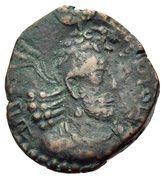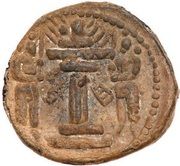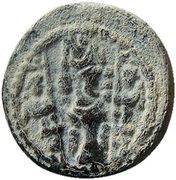Предметы Sasanian Empire (224-651)
Do you want to take a photo with the camera or select an existing image?
(en) The name "Persia" (in ancient persian: Pārsa) has been for a long time used to refer to the nation of modern Iran, their own people and own ancient empires. It is defined as "Great Persia" the territory that had a significant cultural influence and historical importanc; this includes not only Iran, but also the current republics of Afghanistan, Azerbaijan, Tajikistan, the regions of the Caucasus, western Asia, central Asia and parts of southern Asia, until India and China. It has been ruled from the 6th century BC to the 7th century AD by various imperial dynasties, such as the Achaemenids, the Macedonians, the Seleucids, the Parthians, and the Sasanians, up to the Islamic rising and the Arab Caliphates. Around 550 BC King Cyrus II of Persia, known as Cyrus the Great, founded the Achaemenid dynasty. Between 522 and 486 BC King Darius I brought the Empire to its greatest extension establishing a precise administrative and financial structure, dividing it into satrapies (Persian provinces). The decline of the Empire occurred in 330 BC with the defeat of Darius III by Alexander the Great. The empire of Alexander shattered after his death and one of his general, Seleucus I, seized part of it. Thus the Seleucid dynasty began. This dynasty gradually lost the control of Persia and around 247 BC the Arsacid dynasty conquered Partia and founded the Parthian Empire. In 224 AD, following the fall of the Parthian Empire, Ardashir I established the Sasanian empire. It was the last pre-Islamic Persian empire. In fact, it was conquered by Rashidun Caliphate (one of the firsts Islamic states). Several cities continued to resist against the Islamic authority, but around 651 AD most of its territory was annexed to the Islamic caliphate, thus completing the fall of this empire.
- Indo-Sasanian Kingdom
- Sasanian Empire
Персидские империи › Sasanian Empire (224-651) › Indo-Sasanian Kingdom • Drachm (230 AD-360 AD)
AV Dinar (1) - AR Drachm (¹⁄₁₂) - AE pashiz / AE unit / AE Chalkous (¹⁄₅₇₆)
(230-240)
Монеты › Стандартные монеты обращения
Биллон • 2.63 g
Herfeld# 2, N# 80668
(230-240)
Монеты › Стандартные монеты обращения
Биллон • 3.45 g • ⌀ 17.2 mm
Herfeld# 3, Göbl Kushan# 1028, N# 79801
(242-252)
Монеты › Стандартные монеты обращения
Биллон • 4.46 g • ⌀ 17 mm
Herfeld# 6, Göbl Kushan# 1117, N# 73165
(252-256)
Монеты › Стандартные монеты обращения
Медь • 1.46 g • ⌀ 14 mm
Herfeld# 8, N# 131462
(256-264)
Монеты › Стандартные монеты обращения
Биллон • 2.20 g • ⌀ 15 mm
Herfeld# 12, N# 82325
(256-264)
Монеты › Стандартные монеты обращения
Биллон • 1.95 g • ⌀ 15 mm
Herfeld# 13, Göbl Kushan# 1034, N# 82324
(256-264)
Монеты › Стандартные монеты обращения
Биллон • 2.2 g • ⌀ 15 mm
Herfeld# 14, Mitch WI# 1280/1283, N# 65903
(256-264)
Монеты › Стандартные монеты обращения
Биллон • 2.2 g • ⌀ 15 mm
Herfeld# 14, Göbl Kushan# 1052, Mitch WI# 1281, N# 65904
(264-272)
Монеты › Стандартные монеты обращения
Биллон • 3.72 g • ⌀ 18 mm
Herfeld# 16, N# 82323
(264-272)
Монеты › Стандартные монеты обращения
Биллон • 2.14 g • ⌀ 12 mm
Herfeld# 17, Mitch AC# 1293, N# 79027
(284-302)
Монеты › Стандартные монеты обращения
Медь • 3.57 g • ⌀ 14 mm
Herfeld# 27-29, N# 184529
(302-309)
Монеты › Стандартные монеты обращения
Биллон • 2.04 g • ⌀ 14 mm
Herfeld# 31, Göbl Kushan# 1081/1082/1083/1084, N# 73105
(256-264)
Монеты › Стандартные монеты обращения
Серебро • 3.90 g • ⌀ 25 mm
Herfeld# 11, Göbl Kushan# 1031, Göbl Antike# 3670, N# 80667
(330-365)
Монеты › Стандартные монеты обращения
Серебро • 2.91 g • ⌀ 28.5 mm
Herfeld# 23, Göbl Kushan# 8, N# 154812
(252-256)
Монеты › Юбилейные монета обращения: Императорская серия
Золото • 8.06 g • ⌀ 32 mm
Herfeld# 7, N# 73112
(256-264)
Монеты › Юбилейные монета обращения
Золото • 7.79 g
Herfeld# 9, N# 73111
(264-272)
Монеты › Юбилейные монета обращения: Императорская серия
Золото • 7.83 g
Herfeld# 15, Mitch WI# 1287, N# 73166
(272-273)
Монеты › Юбилейные монета обращения: Императорская серия
Золото • 8.22 g
Herfeld# 18, Göbl Kushan# 715, N# 87356
(273-275)
Монеты › Юбилейные монета обращения
Золото • 8.06 g • ⌀ 32 mm
Herfeld# 21, N# 72994
(275-276)
Монеты › Юбилейные монета обращения
Золото • 7.19 g
Herfeld# 22, Göbl Kushan# 735/9, N# 73167
(300-303)
Монеты › Монеты не для обращения: Церемониальные цели
Золото • 8.01 g • ⌀ 31 mm
N# 411214
(475-525)
Монеты › Стандартные монеты обращения
Электрум • 7.0 g • ⌀ 16 mm
Fr# 243, N# 85458
(265-295)
Монеты › Стандартные монеты обращения
Бронза • 2.11 g • ⌀ 15 mm
ANS Kushan# 2235, N# 410125
Персидские империи › Sasanian Empire (224-651) › Sasanian Empire • Динар (224 после Р.Х.-651 после Р.Х.)
Dinar = 3 Tetradrachms = 12 Drachms = 24 Hemidrachms = 36 pashiz / Æ16 Chalkoi = 72 Obols / Dang
(223-240)
Монеты › Стандартные монеты обращения
Бронза • 3.1 g
SNS Schaaf# IIIb/3b, Göbl Sasan# II/1/2, N# 416477
(224-240)
Монеты › Стандартные монеты обращения
Медь • 3.28 g
SNS Schaaf# 3-4-5, N# 122482
(224-241)
Монеты › Стандартные монеты обращения
Медь • 3.07 g
Göbl Sasan# II, SNS Schaaf# 16-19-20, Val Sn# 7, N# 87966
(224-241)
Монеты › Стандартные монеты обращения
Медь • 2.91 g
Göbl Sasan# III/1/2, SNS Schaaf# 37, N# 87443
(224-241)
Монеты › Шаблон: Специальные выпуски
Медь • 1.99 g
Göbl Sasan# III/1a/2, SNS Schaaf# 40, N# 124336
(226-228)
Монеты › Стандартные монеты обращения
Бронза • 4.13 g • ⌀ 16 mm
SNS Iran# IIi/3a, Göbl Sasan# II/2, Sunrise# 701, N# 416468
(260-272)
Монеты › Юбилейные монета обращения: Завоевание на Востоке
Медь • 3.09 g • ⌀ 17 mm
N# 419116
(273-276)
Монеты › Стандартные монеты обращения
Бронза • 3.19 g • ⌀ 18 mm
SNS PBW1# I(1)/1ab(1a), N# 450880
(309-379)
Монеты › Стандартные монеты обращения
Свинец • 2.4 g
SNS Iran# 1a/3a, Sunrise# 862-A, N# 417333
(309-379)
Монеты › Стандартные монеты обращения
Медь • 4.27 g • ⌀ 15.87 mm
ACR# 1328, N# 49103
(388-399)
Монеты › Стандартные монеты обращения
Свинец • 3.90 g • ⌀ 16 mm
N# 419174
(388-399)
Монеты › Стандартные монеты обращения
Свинец • 2.16 g • ⌀ 15 mm
N# 419176
(388-399)
Монеты › Стандартные монеты обращения
Свинец • 3.68 g • ⌀ 18 mm
Zeno cat# 2796, N# 419179
(399-420)
Монеты › Стандартные монеты обращения
Свинец • 3.07 g • ⌀ 16 mm
N# 419186
(399-420)
Монеты › Стандартные монеты обращения
Свинец • 2.58 g • ⌀ 15 mm
N# 419188
(420-438)
Монеты › Стандартные монеты обращения: Second Series
Свинец • 4.13 g • ⌀ 19 mm
N# 419646
(420-438)
Монеты › Стандартные монеты обращения: Second Series
Свинец • 2.81 g • ⌀ 19 mm
N# 419647
(420-438)
Монеты › Стандартные монеты обращения
Свинец • 2.92 g • ⌀ 17 mm
N# 419648
(420-438)
Монеты › Стандартные монеты обращения
Свинец • 3.28 g • ⌀ 16 mm
N# 419649
(420-438)
Монеты › Стандартные монеты обращения
Медь • 1.38 g • ⌀ 18 mm
Göbl Sasan# I/1, N# 419650
(420-438)
Монеты › Стандартные монеты обращения
Свинец • 4 g • ⌀ 20 mm
Göbl Sasan# I/1, SNS Schaaf# 432-433, N# 87967
(438-457)
Монеты › Стандартные монеты обращения
• 2.00 g • ⌀ 15 mm
Göbl Sasan# I/1, N# 419652
(488-531)
Монеты › Стандартные монеты обращения
Медь • 1.8 g • ⌀ 14 mm
Göbl Sasan# V/2, SNS Schaaf# 545-547, Val Sn# 41, N# 74376
(499-531)
Монеты › Стандартные монеты обращения: Second reign
Бронза • 1.94 g
SNS Iran# Ib/3a (pl. 137, A26-8), Göbl Sasan# II/4 (pl. 11, 192), Sunrise# 969, N# 414045
(531-579)
Монеты › Стандартные монеты обращения
Медь • 0.95 g • ⌀ 17 mm
Göbl Sasan# I/1, N# 158615
(590-628)
Монеты › Юбилейные монета обращения
Медь • 1.70 g • ⌀ 25 mm
Sunrise# 988 var., N# 419860
Numista рецензент для монет этого эмитента - yashabykho.
Предмет отсутствует в каталоге? Добавьте сами! (на Английском)



































































































